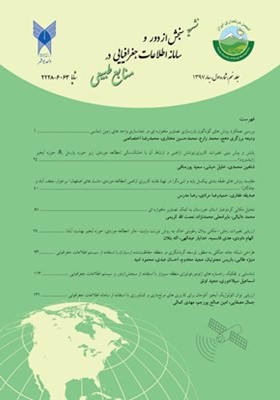تحلیل مکانی گردوغبار استان خوزستان به کمک تصاویر ماهواره ای
محورهای موضوعی : توسعه سیستم های مکانی
محمد دانیالی
1
*
![]() ,
بایرامعلی محمدنژاد
2
,
نعمت الله کریمی
3
,
بایرامعلی محمدنژاد
2
,
نعمت الله کریمی
3
1 - دانشجوی کارشناسی ارشد عمران محیطزیست، دانشگاه صنعتی قم
2 - استادیار دانشکده عمران، دانشگاه صنعتی قم
3 - دانشیار مؤسسه تحقیقات آب، وزارت نیرو، تهران
کلید واژه: سنجنده مودیس, خوزستان, سنجش از دور, گردوغبار, عمق اپتیکی آئروسل,
چکیده مقاله :
در سال های اخیر، طوفان های گردوغبار یکی از مهمترین چالش های آلودگی هوای استان خوزستان بوده است. با توجه به پژوهش های مختلفی که تاکنون انجام پذیرفته است، کشورهای عراق و سوریه بهعنوان منشأ اصلی گردوغبارهای رسیده به خوزستان گزارش می گردد که بیانگر لزوم مطالعه پایش مکانی گردوغبارهای این منطقه می باشد. در این تحقیق، با استفاده از شاخص عمق اپتیکی اخذشده از تصاویر سنجنده MODIS، روند تغییرات سالانه گردوغبار استان خوزستان از ماه مارس سال 2000 تا پایان 2016 تعیین گردید. تغییرات اصلی شاخص گردوغباری خوزستان در سال های 2005، 2009 و 2015، بهعنوان شاخص بررسی روند تغییرات مکانی گردوغبار منطقه غرب ایران انتخاب گردید. نتایج نشان داد که شاخص های گردوغباری منطقه غرب ایران در سال 2005 شباهت زیادی با سال 2015 داشته است. بااینوجود در سال 2015 از فعالیت کانون های گردوغباری بخش هایی از شرق و شمال کشور عراق (شمال دریاچه تارتار) کاسته شده و بر فعالیت کانون هایی واقع در داخل و جنوب کشور کویت و شمال شرقی عربستان افزودهشده است. همچنین فعالیت کانون های گردوغباری مناطقی در شمال غربی عراق و شرق سوریه در سال 2009 بهطور موقت افزایش داشته است که منجر به بالا رفتن شاخص های گردوغباری استان خوزستان طی آن سال گردید. در کنار تغییرات فعالیت کانون های خارجی، افزایش فعالیت کانونی در جنوب شرق اهواز هم در سال 2015 در مقایسه با سال های 2005 و 2009 افزایش داشته که با توجه به مجاورت با شهر اهواز می تواند نقش قابلتوجهی در بحران های گردوغباری سال های اخیر استان خوزستان داشته باشد.
In recent years, dust storms have been one of the most important air pollution crises in Khuzestan province. According to various studies, the countries of Iraq and Syria is reported as the main sources of dust over Khuzestan, it is necessary to monitor the spatial patterns of dust sources in the western region of Iran in different years. In this study, using Aerosol Optical Depth (AOD) from the MODIS, annual trend of dust in Khuzestan province was determined from March 2000 through the end of 2016. Three years 2005, 2009, and 2015 as representative of the main changes in the Khuzestan dust index, the spatial variation of dust in the neighbouring western region of Iran were investigated. According to the results, the dust indexes of the western region of Iran in 2005 were similar to 2015. Nevertheless, in 2015, the activities of dust source points in the eastern and northern part of Iraq (north of the Tharthar Lake) were reduced, and the activity of dust source points in the south of Kuwait and northeastern Arabia increased. The activity of dust source points in areas in the northwest of Iraq and eastern Syria in 2009 has temporarily increased significantly, which has led to an increase in dust index of Khuzestan province that year. Along with these changes, the increase of dust activity in southeast Ahwaz in 2015 compared with the years 2005 and 2009, due to the proximity to the city of Ahwaz, could play a significant role in the dust waves of the recent years.
_||_

